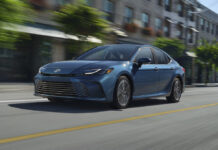New IIHS testing shows there’s still room to improve rear passenger safety in modern crossovers.
Take a look at today’s crossover safety ratings — particularly the Insurance Institute for Highway Safety’s Top Safety Pick or Top Safety Pick+ — and you’ll be forgiven for thinking virtually all crossovers are the same. Based on crash tests over the past few years, you’re not wrong. It’s genuinely difficult to find a model that scores anything lower than the highest “Good” rating across the board. That’s the benefit of 25 years’ worth of safety improvements. However, there’s a caveat: Things aren’t quite so rosy for rear occupants in modern crossovers, as revealed in a new batch of test results.
The cornerstone of the agency’s testing regimen has long been the frontal overlap crash tests. As IIHS President David Harkey points out: “Thanks to automakers’ improvements, drivers in most vehicles are nearly 50% less likely to be killed in a frontal crash today than they were 25 years ago.”
While backseat passengers have a 46% greater risk of injury than front-row passengers in a crash, according to the IIHS’ research, technology to ensure their safety has been lagging behind. “In real-world crashes, chest injuries are the most common serious rear seat injuries for adults, so that’s a key focus,” said research engineer Sushant Jagtap.
The IIHS tested 15 compact crossovers currently available on the market, and here’s how they fared:

Of all 15 crossovers tested, only two scored a “Good” overall rating in the new moderate overlap crash test.
From the Audi Q3 to the Toyota RAV4, all the models in this testing group managed good marks — to the point where crash prevention tech and headlight performance has been the differentiating factor. As before, the new moderate overlap test still sees 40% of the vehicle’s width on the driver’s side hitting a deformable honeycomb barrier at 40 mph.
The key difference is a new rear crash test dummy representing a small woman or 12-year-old child in the second row, placed behind the driver. The test also brings in new metrics that focus on the most common injuries for rear-seat occupants: particularly head, neck and chest injuries. In order to land a good rating, dummy measurements “must not exceed limits indicating excessive risk of injury to the head, neck, chest, abdomen or thigh.” Among those areas, an IIHS engineer said chest injuries were most common among adult rear-seat passengers.
As for the results, only the Ford Escape and Volvo XC40 actually scored a good rating.
The IIHS noted there was no excessive force on the dummy’s chest, misalignment of the safety belts or malfunctioning of the side curtain airbags. The Escape rating applies specifically to cars built after May 2022, when Ford made adjustments to the rear belts.
Most other cars came nowhere close. The only “Acceptable” car is the Toyota RAV4, where IIHS noted movement on the second-row dummy’s lap belt. That could increase the risk of abdominal injuries. The dummy’s head also dipped beneath the side curtain airbag and popped up between the airbag and the window on the rebound.
Three vehicles landed in the “Marginal” category: the Audi Q3, the Nissan Rogue and the Subaru Forester. Evaluators were particularly unimpressed with the high risk for chest injuries in the Forester. The Audi and the Nissan results indicated a higher change of head and neck injuries than the better-rated cars.

All nine poor rated vehicles, including the Mazda CX-5 (shown above) showed high risk of head, neck and chest injuries for rear seat passengers.
In the CX-5’s test, the lap belt moved from the ideal position across the pelvis onto the abdomen. The IIHS noted the dummy’s head came close to contacting the front seatback in the Buick Encore, while it actually hit the C-pillar in the Jeep Renegade hard, showing the side airbags provide inadequate protection.
At the moment, the IIHS does not demand good rear crash test ratings to achieve Top Safety Pick or Top Safety Pick+. It’s possible (and perhaps likely, given the results) that it could happen in due course. These first tests show there’s still plenty of work to do, though, and with this data cars will hopefully improve safety for rear seat passengers soon. “The industry has always been good about responding to tests that we have introduced,” says Harkey. “We expect they will do so in this case, and we expect they will be able to do so quickly.”


























